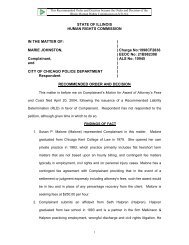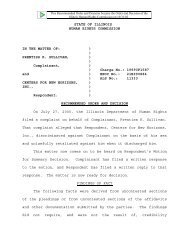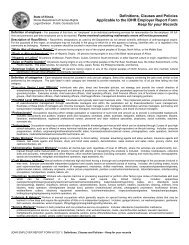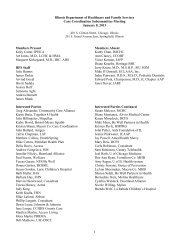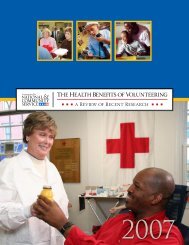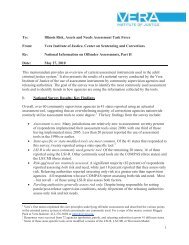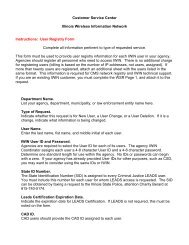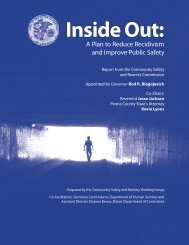lightning safety awareness booklet (PDF, 1.97 MB) - State of Illinois
lightning safety awareness booklet (PDF, 1.97 MB) - State of Illinois
lightning safety awareness booklet (PDF, 1.97 MB) - State of Illinois
You also want an ePaper? Increase the reach of your titles
YUMPU automatically turns print PDFs into web optimized ePapers that Google loves.
LIGHTNING FACT SHEETThere are an estimated 25 million cloud-to-ground <strong>lightning</strong>flashes each year in the United <strong>State</strong>s, nearly 650,000 <strong>of</strong> whichoccur in <strong>Illinois</strong> alone. Lightning can be fascinating to watch,but it is also extremely dangerous – it is the underrated killer.Few people really understand the dangers <strong>of</strong> <strong>lightning</strong>. Manypeople don’t act promptly to protect their lives, property, and thelives <strong>of</strong> others. The first step in solving this potentially lifethreatening problem is through education.Lightning Safety Awareness Week in the state <strong>of</strong> <strong>Illinois</strong> is June 21-27, 2009. Use theinformation in this guide to educate yourself and others about the dangers <strong>of</strong> <strong>lightning</strong>!Lightning SafetyAwareness Weekin the state<strong>of</strong> <strong>Illinois</strong> isJune 21-27, 2009.Lightning Facts• On average, 62 people are killed by <strong>lightning</strong> in the United <strong>State</strong>s each year. This ismore than those killed by tornadoes (54) and hurricanes (49).• It is estimated that more than 1,000 people are injured by <strong>lightning</strong> strikes in theUnited <strong>State</strong>s each year.• In 2008, 28 people were killed by <strong>lightning</strong> strikes in the United <strong>State</strong>s. This islower than the ten-year average <strong>of</strong> 42 fatalities.• Ninety-nine people have been killed by <strong>lightning</strong> in <strong>Illinois</strong> in the past 48 years.• In 2001, <strong>Illinois</strong> ranked SECOND among the 50 states for <strong>lightning</strong> fatalities.• In 2008, 100% <strong>of</strong> <strong>lightning</strong> fatalities occurred outdoors. On average, about 67% <strong>of</strong><strong>lightning</strong> fatalities and injuries occur outdoors at recreation events (baseball games,soccer games, lakes, and on golf courses), and under or near trees.• No place outdoors is safe when a thunderstorm is near!• The odds <strong>of</strong> an individual being a <strong>lightning</strong> casualty are about 280,000-to-one inany given year in the United <strong>State</strong>s. The odds <strong>of</strong> winning the lottery are aHUNDRED times greater!• Lightning results in an economic impact <strong>of</strong> about $5 Billion in the U.S. each year.It is also one <strong>of</strong> the leading causes <strong>of</strong> forest fires.• Lightning is most likely to happen in the spring and summer months, in the lateafternoon or evening.Lightning Safety Awareness 3
OutdoorsWhile no one cancompletelyeliminate the risk<strong>of</strong> being struck by<strong>lightning</strong>, you cangreatly reduceyour risk <strong>of</strong>becoming a<strong>lightning</strong> casualtyby following somebasic rules.While no one can completely eliminate the risk <strong>of</strong> being struck by <strong>lightning</strong>, you cangreatly reduce your risk <strong>of</strong> becoming a <strong>lightning</strong> casualty by following some basic rules.• PLAN AHEAD! If thunderstorms are in the forecast, consider postponingoutdoor activities. At the very least, have a portable NOAA Weather Radio thatwill alert you to changes in the weather.• WATCH THE SKY! Make sure you, or someone in a group <strong>of</strong> people, monitorthe weather conditions. This is especially important if you need time to get to a safeplace. The static on an AM radio frequency can also alert you to approachingthunderstorms.• COACHES & OFFICIALS NEED A SAFETY PLAN! Outdoor events arevery susceptible to <strong>lightning</strong> strikes because these activities take place in open areas.If you, or your children, are involved in outdoor recreational activities, verify thatscout leaders, coaches, umpires, referees, and camp counselors have guidelines forpostponing outdoor events BEFORE thunderstorms approach. The <strong>safety</strong> <strong>of</strong> theparticipants and the spectators must be the number one priority!• WHEN THUNDER ROARS, GO INDOORS! When you can hear thunder,you are close enough to the storm to be struck by <strong>lightning</strong>, even if it isn’t raining!Get indoors immediately! Once indoors, stay there for 30 minutes after hearing thelast rumble <strong>of</strong> thunder before resuming outdoor activities. REME<strong>MB</strong>ER: this is aguideline…and is not as useful if the thunderstorm is actually forming overhead.The first strike <strong>of</strong> <strong>lightning</strong> may occur very near you. You won’t have the ability to“hear it coming”. So remember to keep an "eye on the sky" if clouds begin to buildand darken!• GET AWAY FROM WATER! Stop activities in or near water, such as swimming,boating, fishing, and camping and seek a substantial shelter.• LIGHTNING SAFETY TIPS – OUTDOORS:◆◆◆◆◆The best shelter from <strong>lightning</strong> is inside a substantial building.Avoid car ports, porches, garages, sheds, tents, baseball dugouts, or underbleachers.If no substantial shelter is available, seek refuge in a hard topped vehicle, withthe windows up.Stay away from trees, electrical poles, or other tall objects.If your hair stands on end, or you experience a tingling sensation – <strong>lightning</strong>may strike soon! DO NOT LIE FLAT ON THE GROUND! Crouch downon the balls <strong>of</strong> your feet to create the lowest pr<strong>of</strong>ile.4 Lightning Safety Awareness
Lightning Safety On the JobPeople who work outdoors in open spaces, on or near tall objects, with explosives, or withmetal have a large exposure to <strong>lightning</strong> risks. Workers in these occupations are amongthose with the most risk:• Farming and Field Labor• Power / Utility field repair• Construction and Building Maintenance• Heavy Equipment Operation• Plumbing and Pipefitting• Explosives Handling or Storage• Logging◆◆DON’T START ANYTHING THAT CAN’T BE STOPPED QUICKLYPay attention to the daily forecast so you know what to expect. Be alert forearly signs <strong>of</strong> thunderstorms such as increasing winds, dark clouds, rain ordistant rumbles <strong>of</strong> thunder.KNOW YOUR COMPANY’S SAFETY GUIDELINESBusinesses with high risk functions, such as explosives handling or utility repairduring severe weather, should have a formal <strong>lightning</strong> warning policy that meetsthese two requirements:■■Lightning danger warnings that can be issued in time for everyone to get toa safe locationAccess to a safe place◆◆ASSESS YOUR LIGHTNING RISK AND TAKE ACTIONWhen you hear thunder, you are close enough to the storm to be struck. Stopwhat you are doing immediately and take shelter in a substantial building or ina hard topped vehicle.OBJECTS & EQUIPMENT TO AVOIDWhen you hearthunder, you areclose enough tothe storm to bestruck.■■■■Anything tall or high, including ro<strong>of</strong>s, scaffolding, ladders, utility poles, ortrees.Large equipment such as bulldozers, cranes, backhoes, and tractors.Materials or surfaces that conduct electricity like metal tools or equipment,utility lines, water, water pipes, and plumbing.Leave areas where explosives or munitions are located.◆IF A CO-WORKER IS STRUCK BY LIGHTNINGLightning victims are safe to handle – they do NOT carry any electrical charge.Call 9-1-1 IMMEDIATELY! If the victim’s heart is stopped or they stoppedbreathing, administer CPR immediately, if properly trained.Lightning Safety Awareness 5
IndoorsA house or other substantial building <strong>of</strong>fers the best protection from <strong>lightning</strong>. Openshelters, carports, garages and sheds are designed to protect people and property fromrain and sun – NOT <strong>lightning</strong>.There are three main ways <strong>lightning</strong> enters a building:1. A direct strike2. Through wires or pipes that extend outside the building3. Through the groundOnce in a structure, the current from a <strong>lightning</strong> strike can travel through electrical lines,plumbing, phone lines, and radio or TV reception systems. Lightning can also travelthrough any metal wiring or bars in concrete walls or flooring.• AVOID CONTACT WITH CORDED PHONES Phone use is theleading cause <strong>of</strong> indoor <strong>lightning</strong> injuries in the United <strong>State</strong>s. Cordless phonesare safe, as long as <strong>lightning</strong> does not strike while you are removing the phonefrom the charging cradle. Cell phones are the safest method <strong>of</strong> communication.• STAY AWAY FROM WINDOWS AND EXTERIOR DOORS Windowsand doors can provide a path for a direct strike to enter a home.• STAY OFF OF PORCHES AND DECKS Even if a porch or deck iscovered, it does not <strong>of</strong>fer any protection from <strong>lightning</strong> strikes.Direct strikes andpower surges dueto <strong>lightning</strong>causes significantdamage topersonal propertyeach year.• AVOID CONTACT WITH ELECTRICAL EQUIPMENT OR CORDSDirect strikes and power surges due to <strong>lightning</strong> cause significant damage topersonal property each year. If you plan to unplug any electronic equipment, doso well before the storm arrives. Do not forget to disconnect televisions andradios from outdoor antennas.• STAY AWAY FROM PLU<strong>MB</strong>ING AND PLU<strong>MB</strong>ING APPLIANCESAvoid contact with pipes during a thunderstorm. Do not take a shower or bath.Avoid appliances such as dishwashers, washing machines, and electric hot waterheaters, since they utilize both water and electricity.• BE ALERT FOR DIRECT LIGHTNING STRIKES If your home, or aneighbor’s home is directly struck by <strong>lightning</strong>, call the fire departmentimmediately! Have the electrical wiring in your home inspected by a qualifiedelectrical contractor as soon as possible.6 Lightning Safety Awareness
Lightning Strike InjuriesIf a person is struck by <strong>lightning</strong>, immediate medical attention may be the difference betweenlife and death. With proper medical treatment, most victims can survive a <strong>lightning</strong>strike. However, the long-term effects on their lives and the lives <strong>of</strong> their familymembers can be devastating.• VICTIMS DO NOT CARRY ANY ELECTRICAL CHARGE It isimportant that <strong>lightning</strong> strike victims receive immediate medical attention –call 9-1-1! They are safe to handle and can not injure anyone providingmedical attention.If a person isstruck by <strong>lightning</strong>,immediatemedical attentionmay be the differencebetween lifeand death.• LIGHTNING CAUSES CARDIAC ARREST IN MOST FATALITIESThe surge <strong>of</strong> electricity through a person’s body results in cardiac arrest beingthe immediate cause <strong>of</strong> death in most <strong>lightning</strong> fatalities. Check to see if a<strong>lightning</strong> victim has a pulse and is breathing. If not, administer CPRimmediately and get the victim advanced life-saving medical attention.• ONLY A FEW VICTIMS SUFFER BURNS Physically, only a few<strong>lightning</strong> strike victims actually suffer burns, and these are usually minor. Most<strong>lightning</strong> burns occur in the extremities where the current either enters or exitsthe body.• SOME OF THE LONG-TERM SIDE EFFECTS REPORTED BYLIGHTNING STRIKE SURVIVORS ARE:◆ Memory loss◆ Personality changes◆ Difficulty carrying on more than one task at a time◆ Fatigue◆ Irreparable nerve damage◆ Chronic pain and/or headaches◆ Difficulty sleeping◆ DizzinessNote: Some symptoms may not appear until several months after the <strong>lightning</strong> strike!The main support group for <strong>lightning</strong> strike survivors is “Lightning Strike and ElectricShock Survivors, International” (www.<strong>lightning</strong>-strike.org)Lightning Safety Awareness 7
The Science <strong>of</strong> LightningBy definition, all thunderstorms contain <strong>lightning</strong>. Lightning can strike the ground orground-based objects, within the thunderstorm cloud, from one thunderstorm to another,or into the atmosphere. Thunderstorms are most likely to develop on warm springor summer days, but they can occur any time <strong>of</strong> the year.Lightning is producedbecause<strong>of</strong> the mixture andcollisions <strong>of</strong> icecrystals, high inthe thunderstorm,with rain dropsand hailstones inthe lower parts <strong>of</strong>the storm.THE DEVELOPMENT OF A THUNDERSTORMPockets <strong>of</strong> air rise into the atmosphere, either forced by a front or due to heating <strong>of</strong> theearth on a sunny day. When this air reaches a certain level in the atmosphere, cumulusclouds start to form. Continued heating <strong>of</strong> the moist air can cause these clouds to growvertically upward in the atmosphere, into “towering cumulus” clouds. These clouds maybe the first indication <strong>of</strong> a developing thunderstorm, or cumulonimbus cloud.HOW LIGHTNING FORMSLightning is produced because <strong>of</strong> the mixture and collisions <strong>of</strong> ice crystals, high in thethunderstorm, with rain drops and hailstones in the lower parts <strong>of</strong> the storm. The lighterice crystals become positively charged, and are carried into the highest parts <strong>of</strong> the cloud.Heavier hail and rain gathers a negative charge and falls toward the lower part <strong>of</strong> thecloud. The earth’s surface normally has a slight negative charge. However, as the negativecharges build-up in the lower part <strong>of</strong> the cloud, the ground beneath it and surroundinglocations become positively charged. Initially the air acts as an insulatorbetween these differing charges. However, when the electrical potential between thetwo charges becomes too great, there is a discharge <strong>of</strong> electricity known as LIGHT-NING.8 Lightning Safety AwarenessLIGHTNING & THUNDERLightning is the giant spark <strong>of</strong> electricity that occurs within the atmosphere. As it passesthrough the air, the one inch diameter or less, bolt <strong>of</strong> <strong>lightning</strong> rapidly heats the air toa temperature <strong>of</strong> 50,000 ºF – which is hotter than the surface <strong>of</strong> the sun! The air expandsrapidly due to the heating, then quickly contracts as it cools back to its normal temperature.This creates a shockwave that we hear as THUNDER.HEAT LIGHTNINGHeat <strong>lightning</strong> is simply the <strong>lightning</strong> from a distant thunderstorm that is too far awayfor the resultant thunder to be heard. In most cases, the light you observe is being reflected<strong>of</strong>f <strong>of</strong> clouds, near the horizon, tens <strong>of</strong> miles away. Keep an eye on the stormthough, since it may be headed in your direction.Little Known Lightning Facts• Many cloud-to-ground <strong>lightning</strong> flashes have “forked” or multiple attachmentpoints to earth. Recent studies indicated that 50-70% <strong>of</strong> cloud-to-ground<strong>lightning</strong> strikes are forked.• Lightning can spread out nearly 60 feet after striking the earth, depending onsoil characteristics.• Lightning can strike the same place twice!• An increase in <strong>lightning</strong> activity, or a rapid change in <strong>lightning</strong> polarity can bea precursor to a severe thunderstorm or tornado.
Sources <strong>of</strong> Lightning and WeatherSafety InformationFor additional information on <strong>lightning</strong> and other severe weather hazards, contact thefollowing:Your local Emergency Management Agency (EMA)<strong>Illinois</strong> Emergency Management Agencywww.state.il.us/iemaYour local chapter <strong>of</strong> the American Red Cross (ARC) or www.redcross.orgThe National Lightning Safety Institutewww.<strong>lightning</strong><strong>safety</strong>.comThe National Weather Service Lightning Safety websitewww.<strong>lightning</strong><strong>safety</strong>.noaa.govReady <strong>Illinois</strong>www.ready.illinois.govCOACH’S and SPORTS OFFICIAL’S GUIDE TO LIGHTNING SAFETYhttp://www.<strong>lightning</strong><strong>safety</strong>.noaa.gov/resources/CoachGuide.pdfThe nearest <strong>of</strong>fice <strong>of</strong> the National Weather Service (NWS)National Weather Service Forecast Office websites:Davenport, IARomeoville, ILLincoln, ILSt. Louis, MOPaducah, KYwww.crh.noaa.gov/dvnwww.crh.noaa.gov/lotwww.crh.noaa.gov/ilxwww.crh.noaa.gov/lsxwww.crh.noaa.gov/pahLightning Safety Awareness 9
10 Lightning Safety AwarenessNOAA WEATHER RADIOListen to NOAA Weather Radio All Hazards for the latest weather forecasts. The NationalWeather Service broadcasts weather information, including watches, warnings and advisories 24hours a day. Weather radio transmitters have a range <strong>of</strong> about 40 miles. Weather radio transmittersthat cover <strong>Illinois</strong> are shown below. To determine the weather radio coverage area foreach county in <strong>Illinois</strong>, go to:http://www.nws.noaa.gov/nwr/CntyCov/nwrIL.htmCITY STATION FREQUENCYBloomington KZZ-65 162.525 MHZCape Girardeau, MO KXI-93 162.550 MHZChampaign WXJ-76 162.550 MHZChester KXI-42 162.450 MHZChicago KWO-39 162.550 MHZCrescent City KXI-86 162.500 MHZCrystal Lake KXI-41 162.500 MHZDeKalb WNG-536 162.550 MHZDixon KZZ-55 162.525 MHZDubuque, IA WXL-64 162.400 MHZEdwardsport, IN WWG-82 162.425 MHZEvansville, IN KIG-76 162.550 MHZFreeport KZZ-56 162.450 MHZGalesburg KZZ-66 162.400 MHZHannibal, MO WXK-82 162.475 MHZHillsboro KXI-79 162.425 MHZJacksonville WXM-90 162.525 MHZJerseyville KXI-70 162.450 MHZKankakee KZZ-58 162.525 MHZLockport KZZ-81 162.425 MHZMacomb WXJ-92 162.500 MHZMaquoketa, IA KZZ-83 162.500 MHZMarion WXM-49 162.425 MHZMayfield, KY KIH-46 162.475 MHZMcLeansboro KXI-52 162.400 MHZMedill, MO WXL-99 162.450 MHZNewton KXI-48 162.450 MHZOdell WXK-24 162.450 MHZParis KXI-47 162.525 MHZPeoria WXJ-71 162.475 MHZPlano KXI-58 162.400 MHZPrinceton WXL-22 162.425 MHZPutnamville, IN WXK-72 162.400 MHZRacine, WI KZZ-76 162.450 MHZRock Island (Moline) WXJ-73 162.550 MHZRockford KZZ-57 162.475 MHZSalem KXI-49 162.475 MHZShelbyville KXI-46 162.500 MHZSpringfield WXJ-75 162.400 MHZSt. Louis, MO KDO-89 162.550 MHZWest Burlington, IA WXN-83 162.525 MHZ
Printed by the Authority <strong>of</strong> the <strong>State</strong> <strong>of</strong> <strong>Illinois</strong>IOCI 1197-09 - PO#675 - 500 - 6/09



